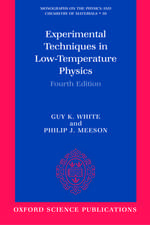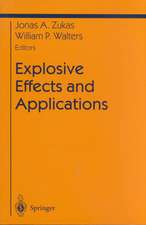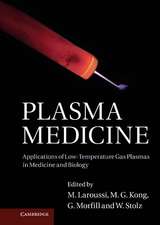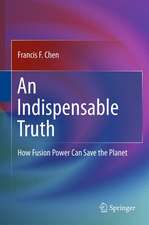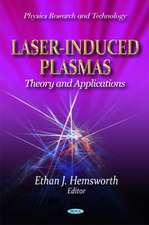Magnetocumulative Generators: Shock Wave and High Pressure Phenomena
Autor Larry L. Altgilbers Prefață de C.M. Fowler Autor Mark D.J. Brown, Igor Grishnaev, Bucur M. Novac, Ivor R. Smith, Yuriy Tkach, Iaroslav Tkachen Limba Engleză Hardback – 14 ian 2000
| Toate formatele și edițiile | Preț | Express |
|---|---|---|
| Paperback (1) | 951.29 lei 6-8 săpt. | |
| Springer – 5 noi 2012 | 951.29 lei 6-8 săpt. | |
| Hardback (1) | 957.44 lei 6-8 săpt. | |
| Springer – 14 ian 2000 | 957.44 lei 6-8 săpt. |
Din seria Shock Wave and High Pressure Phenomena
- 15%
 Preț: 651.67 lei
Preț: 651.67 lei - 24%
 Preț: 804.03 lei
Preț: 804.03 lei - 18%
 Preț: 2099.77 lei
Preț: 2099.77 lei - 18%
 Preț: 1111.97 lei
Preț: 1111.97 lei - 15%
 Preț: 645.28 lei
Preț: 645.28 lei - 18%
 Preț: 948.29 lei
Preț: 948.29 lei - 15%
 Preț: 532.38 lei
Preț: 532.38 lei - 18%
 Preț: 1235.25 lei
Preț: 1235.25 lei - 18%
 Preț: 1132.65 lei
Preț: 1132.65 lei - 18%
 Preț: 1228.96 lei
Preț: 1228.96 lei -
 Preț: 397.01 lei
Preț: 397.01 lei - 18%
 Preț: 949.10 lei
Preț: 949.10 lei - 15%
 Preț: 634.32 lei
Preț: 634.32 lei - 18%
 Preț: 1546.86 lei
Preț: 1546.86 lei - 24%
 Preț: 1040.54 lei
Preț: 1040.54 lei - 15%
 Preț: 642.03 lei
Preț: 642.03 lei - 18%
 Preț: 892.90 lei
Preț: 892.90 lei - 20%
 Preț: 560.55 lei
Preț: 560.55 lei - 18%
 Preț: 1390.73 lei
Preț: 1390.73 lei - 18%
 Preț: 947.50 lei
Preț: 947.50 lei - 18%
 Preț: 1126.69 lei
Preț: 1126.69 lei -
 Preț: 384.70 lei
Preț: 384.70 lei - 15%
 Preț: 649.39 lei
Preț: 649.39 lei - 18%
 Preț: 1382.21 lei
Preț: 1382.21 lei -
 Preț: 392.21 lei
Preț: 392.21 lei - 15%
 Preț: 596.36 lei
Preț: 596.36 lei - 18%
 Preț: 1554.72 lei
Preț: 1554.72 lei - 18%
 Preț: 1228.29 lei
Preț: 1228.29 lei - 15%
 Preț: 644.30 lei
Preț: 644.30 lei - 18%
 Preț: 891.80 lei
Preț: 891.80 lei - 18%
 Preț: 951.14 lei
Preț: 951.14 lei - 15%
 Preț: 534.82 lei
Preț: 534.82 lei -
 Preț: 391.79 lei
Preț: 391.79 lei
Preț: 957.44 lei
Preț vechi: 1167.61 lei
-18% Nou
Puncte Express: 1436
Preț estimativ în valută:
183.23€ • 189.03$ • 155.08£
183.23€ • 189.03$ • 155.08£
Carte tipărită la comandă
Livrare economică 05-19 martie
Preluare comenzi: 021 569.72.76
Specificații
ISBN-13: 9780387987866
ISBN-10: 038798786X
Pagini: 422
Ilustrații: XII, 422 p.
Dimensiuni: 155 x 235 x 25 mm
Greutate: 0.79 kg
Ediția:2000
Editura: Springer
Colecția Springer
Seria Shock Wave and High Pressure Phenomena
Locul publicării:New York, NY, United States
ISBN-10: 038798786X
Pagini: 422
Ilustrații: XII, 422 p.
Dimensiuni: 155 x 235 x 25 mm
Greutate: 0.79 kg
Ediția:2000
Editura: Springer
Colecția Springer
Seria Shock Wave and High Pressure Phenomena
Locul publicării:New York, NY, United States
Public țintă
ResearchCuprins
1 Explosive-Driven Power Sources.- 1.1 Introduction.- 1.2 Overview of Explosive-Driven Power Sources.- 1.3 Magnetocumulative Generator History.- 1.4 Electromagnetic Theory.- 1.5 Electromagnetic Phenomena.- 1.6 Shock and Detonation Waves.- 1.7 Explosives and Explosive Components.- 1.8 Introduction to MCGs.- References.- 2 Magnetocumulative Generator Physics and Design.- 2.1 Conditions That Affect Magnetic Field Compression.- 2.2 Theory of Magnetocumulative Current Generators.- 2.3 Current Generator Design Issues.- References.- 3 Magnetocumulative Generators.- 3.1 Introduction.- 3.2 Classifications of MCGs.- 3.3 Coaxial MCGs.- 3.4 Spiral (Helical) MCGs.- 3.5 Plate MCGs.- 3.6 Loop MCGs.- 3.7 Disk MCGs.- 3.8 Semiconductor MCGs.- 3.9 Cascaded MCGs.- 3.10 Short-Pulse MCGs.- References.- 4 Pulse-Forming Networks.- 4.1 High-Speed Opening Switches.- 4.2 Pulsed Transformers.- 4.3 Spark Gap Switches.- 4.4 Pulse-Forming Lines.- 4.5 High-Voltage MCG Systems.- References.- 5 Electrical Loads.- 5.1 Direct Connection to a Load.- 5.2 Connection Through Pulsed Transformers.- 5.3 Connecting Through an Electroexplosive Switch.- 5.4 Pulsed Transformer and Electroexplosive Switch.- References.- 6 Design, Construction, and Testing.- 6.1 A Brief Description of FLEXY I.- 6.2 Computer Models.- 6.3 Helical Generator Design.- 6.4 Construction of the FLEXY I.- 6.5 Testing the FLEXY I.- 6.6 Comparison of Theoretical and Experimental Results.- 6.7 Summary.- References.- 7 Experimental Methods and Techniques.- 7.1 Experimental Methods.- 7.2 Explosive Pulsed Power Laboratory.- 7.3 Testing Fast Switches and Conditioning Circuits.- 7.4 Magnetic Coupling between MCGs.- 7.5 Limitations of Helical MCGs.- 7.6 Summary.- References.- 8 Applications: Lasers and Microwaves.- 8.1 Lasers.- 8.2 High-Power MicrowaveSources.- 8.3 Direct-Drive Devices.- 8.4 Summary.- References.

